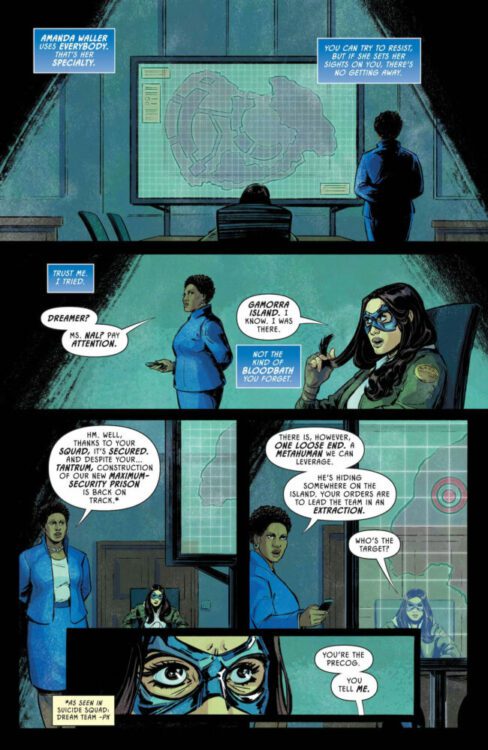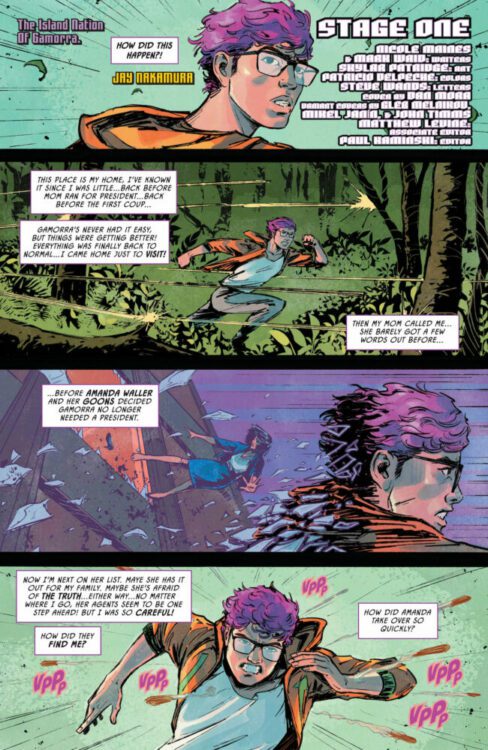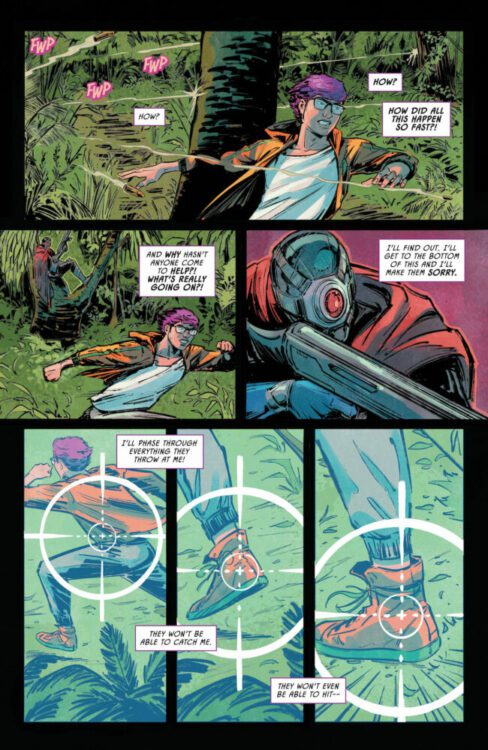Absolute Power: Ground Zero #1 is an anthology one-shot from DC Comics written by Mark Waid, Nicole Maines, Chip Zdarsky, and Joshua Williamson, and lettered by Steve Wands. The issue is drawn by Skylar Patridge, V Ken Marion, and Gleb Melnikov, with colors from Patricio Delpeche and Melnikov.
The issue features three stories, the first of which follows Dreamer and the Suicide Squad hunting down Jay Nakamura for Amanda Waller. It’s unsure why Waller wants Jay, but she says that she has a way to leverage him. Dreamer is obviously reluctant in doing this as she’s being blackmailed herself, and wants to take Waller down. The second story features Waller capturing John Starr, the Time Commander, and using him to rebuild something that she needs to fully enact her plans. The third story features Waller conditioning the new Brainiac Queen in order for her to utilize her properly in the coming days. All three stories feature Waller getting ready for her big final play, leading into DC’s big summer event, Absolute Power.

WRITING
The first story is written by Maines and Waid, and it picks up after the ending of Suicide Squad: Dream Team, with Dreamer plotting on how to take down Waller. Having portrayed Nia Nal in the live action DC TV shows, it’s clear that Maines has a strong voice for the character. What really shines in this story is how Maines highlights Nia’s reluctance to work with Waller. She shows how Dreamer is only doing this because Waller is holding Nia’s family hostage, and how she hates her. It’s the point in the issue where the stakes feel the highest because of that.
Waid and Maines write a ruthless Waller, but not a reckless one. She’s cold and methodical, using whatever she can to push her own agenda forward. Dreamer is the best character they could’ve put in this position. She’s still fairly new to the page, and so she’s without that baggage and history that most of the other characters in this universe have. This story helps in strengthening her personality and really gets you invested in her through that.
The second story is written by Waid and Zdarsky, and they dive into what Zdarsky had written in recent issues of Batman. The small problem is that Batman provided a satisfying enough ending already to the “Failsafe” storyline. To return to that here makes you wonder why. The goal of the story is to undo the destruction of Failsafe, but in doing so, it cheapens the conclusion Zdarsky had already written for the characters in the pages of Batman.
They use Time Commander as a narrator, and the strength in that is the same as the first story’s strength. John Starr isn’t a new character, but he’s been away long enough for his perspective to feel new and fresh. He’s as confused as we are, and something that all three writers do here is use a character the reader may not know much about in order to tell us as little of what Waller is planning as possible. They notice that she keeps things secret, but they don’t know what. They also know their place, so they’re too scared to push it. We know only what Zdarsky and Waid want us to.
The final story comes from Williamson alone, and it’s the strongest in showing the lengths Waller would go to in order to enact her plans. Williamson writes a more emotional Waller, but it’s unclear whether that’s all part of her act or not. The story keeps you guessing, but provides a meaningful and surprisingly emotionally charged explanation as to why the Brainiac Queen joins Waller. Williamson finishes the story with all of the pieces ready to go now in the main event, and it ends on a note that makes the reader want to see what comes next.

ART
Starting with Patridge’s work on the first story, she comes out of the gate swinging. Not only does she immediately capture the tone of the story through facial expressions and hasty actions, but she also adds more of an emotional core to the story. You can see how Dreamer is horrified by what Waller wants to do, but she plays along. You can see the horror and determination in Jay’s face as he runs from Waller’s people. It’s all there. There’s this one great panel (seen above) where Jay is running, but the background behind him turns into the image of his mother being thrown out of a window. The glass shards turn into him as he continues to run. Attention to detail is key here, and what we have really amplifies the stakes.
Next is art from Marion in the second story. His work is incredibly detailed and expressive here, specifically the action. There’s a page that shows a flashback of a fight between Batman and Failsafe. The implied motion of it is really strong and shows both characters putting their all into their respective blows. Another example of really great detail is when we’re shown the inside of the robot while it’s hooked up to a separate machine. Every last detail and part of the machine is shown, making it feel less hollow later when shown in full force. The art here just really added a great perspective to the characters.
Finally, there’s Melnikov. Having drawn Superman before, nothing feels out of place. He’s already gotten his feel for the character and his supporting cast down, and uses that well here in showing them and Metropolis. This story is from the perspective of Waller in an artificial world, but with the Brainiac Queen around, there’s a very innocent feeling attached to it. The art makes you feel like you’re at home where you’re supposed to be, it makes you comfortable. When returned to the real world, the art and feel once again becomes cold and strategic. It’s a well done shift.

COLORS
The colors in the first two stories are both done by Depelche. He uses lighting and shading to hide advantage in both stories. In the first, Jay is shown fully lit up most of the time with Nia always covered in a light shadow, showing that she’s unhappy with what she has to do. The issue starts with Waller’s back turned to the reader, fully shaded as though she’s a silhouette. This immediately introduces us to her as the person we know the least about. The only time Jay is really covered is when Waller initially captures him and right before Dreamer leaves his cell.
In the second story, purple is one of the main colors showcased. A purple glowing hourglass is the main power source for Starr’s powers, and so everyone has to be constantly shaded in the glow of it. It’s done well, but it mostly only appears when John is by himself. Anywhere else the colors feel cold and foreign, especially when around Waller’s people. Something interesting though is that the purple also returns when Starr is with Waller, especially after she gets what she wants. It’s not out of his control, and it fills the room.
Melnikov takes over on colors for the third story that he draws himself, and most of what was said about his art applies here too. It feels very warm and inviting, only drastically shifting to a more menacing and dramatic set of colors when Superman arrives. Waller is creating this experience, so doing this helps to present him as an enemy. His head is shaded with only the red of his heat vision showing. From the perspective of Waller and the Brainiac Queen, he’s this evil enemy sent to bring nothing but pain and suffering.
LETTERS
The lettering is all done by Wands. The introductions to each story really stood out as interesting here. They show up as calculated and mechanical, showing that each story in this one-shot is simply just a means to an end for Waller. It’s what she needs to do to prepare. The text boxes are well placed and never distract from any of what we’re seeing, which is especially noticeable in the second story. The purple of John’s bubbles blend into his powers, and are placed along the glow of them as it’s shown in action.
In the final story, The letters for Failsafe are back and his text boxes are different from how they usually are. Still mechanical, but they now feel more sinister. The boxes are connected through these static lines, and there are spiked breaks in the boxes that help to imagine the cold and technical voice coming from him. Interestingly, Brainiac Queen has normal bubbles. She’s not all machine; she’s what Waller helped mold her into. She’s a reflection of that, and wouldn’t be shown speaking as a robot, but as a person. it’s a great contrast.
CONCLUSION
Absolute Power: Ground Zero #1 gives us some insight to where the story will go, and does a good job of getting us ready for the event. The teams on this issue show very meticulously what the powers in play are, even if it does go back on previous stories in order to do that. This is a very Waller-centric issue, and can only mean that what to expect going forward is a Waller-centered event. It’s time for her plan to be enacted, and she’s going to enjoy it.

